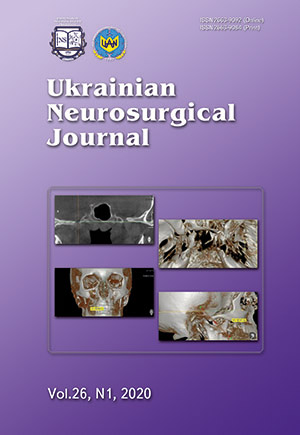Improved method of percutaneous approach to the trigeminal ganglion and sensory root
DOI:
https://doi.org/10.25305/unj.158263Keywords:
trigeminal nerve, neuralgia, trigeminal neuralgia, neurosurgical treatment, percutaneous approachAbstract
Objective. Improvement of the percutaneous approach to the trigeminal ganglion and sensory root through the foramen ovale using modern neuroimaging techniques, which will improve the results of puncture neurosurgical treatment of patients with drug-resistant forms of trigeminal neuralgia.
Materials and methods. From May 2013 to June 2019, 26 patients were under our supervision, out of which there were 8 men and 18 women, aged from 32 to 88 (average age 62.48 ± 11.47) years with refractory forms of trigeminal neuralgia with severe pain syndrome. They underwent 33 interventions by percutaneous approach through the foramen ovale using cone-beam computed tomography (CBCT). The disease duration ranged from 1 to 28 (on average, 7.58 ± 4.83) years. The pain severity on a visual analogue scale (VAS) ranged from 7.1 to 10 (on average, 8.86 ± 0.65) cm.
Results. We have developed a method of percutaneous approach to the trigeminal ganglion and sensory root, taking into account the individual anatomical features of the skull and face of each patient based on preoperative modelling using CBCT with 3D modelling. The method allows to accurately determine the most optimal puncture point on the face, as well as reliable topographic bone landmarks, the angles of puncture needle directions from the puncture point in three planes and the necessary distances. This approach helps to facilitate the procedure, reduce its invasiveness and duration, ensures the successful implementation of puncture access through the foramen ovale.
Conclusions. Based on the method developed by us, we managed to overcome the technical difficulties of percutaneous approach through the foramen ovale, which were due to the anatomical features of the base of the skull and pyramid of the temporal bone and the cicatricial adhesion on the outer surface of the base of the skull.
References
1. Tsymbaliuk V, Sapon N. [Prosopalgia - facial pain]. Doctor. 2003;(1):27-30. Russian. [CrossRef]
2. Pavlenko SS. [State and problems of epidemiological researches of pain syndromes]. Pain. 2006;(4):2-7. Russian. https://elibrary.ru/item.asp?id=23859570
3. Zakrzewska JM, McMillan R. Trigeminal neuralgia: the diagnosis and management of this excruciating and poorly understood facial pain. Postgrad Med J. 2011 Jun;87(1028):410-6. [CrossRef] [PubMed]
4. Burchiel KJ. A new classification for facial pain. Neurosurgery. 2003 Nov;53(5):1164-6; discussion 1166-7. [CrossRef] [PubMed]
5. Agur AMR, Dalley AF. Grant’s Atlas of Anatomy. 12th ed. Lippincott Williams & Wilkins, 2009. 1627 p.
6. Civelek E, Karasu A, Cansever T, Hepgul K, Kiris T, Sabanci A, Canbolat A. Surgical anatomy of the cervical sympathetic trunk during anterolateral approach to cervical spine. Eur Spine J. 2008 Aug;17(8):991-5. [CrossRef] [PubMed] [PubMed Central]
7. Evans RW, Agostoni E. Persistent idiopathic facial pain. Headache. 2006 Sep;46(8):1298-300. [CrossRef] [PubMed]
8. Posokhov MF. [Classification prosopalgia the historical aspect (Literature review)]. Ukrains’kyi visnyk psykhonevrolohii. 2014;22(4):25-32. Ukrainian. https://elibrary.ru/item.asp?id=22938370
9. Posokhov MF. Modern problems in neurosurgical treatment of pharmacoresistant facial pains. Ukrains’kyi visnyk psykhonevrolohii. 2016;24(1):101-103. https://elibrary.ru/item.asp?id=26498958
10. Yavorskaya ES. [Pain and paresthetic syndromes of maxillofacial area]. Kyiv: Medknyha; 2007. Russian.
11. Shchedrenok VV. [Surgery of facial pain]. St. Petersburg: GU RNHI im. prof. A.L. Polenova; 2005. Russian
12. Tsymbalyuk VI, Zorin NА, Latyshev DY. [The first results of treatment of patients with trigeminal neuralgia using balloon microcompression of the trigeminal ganglion]. Ukrainian Neurosurgical Journal. 2007;(2):54-57. Russian. [CrossRef]
13. Wang JY, Bender MT, Bettegowda Ch. Percutaneous Procedures for the Treatment of Trigeminal Neuralgia. Neurosurg Clin N Am. 2016 Jul; 27(3):277-95. [CrossRef] [PubMed]
14. Pavlov BB. [Radiofrequency selectiverhizotomy in the treatment of trigeminal neuralgia]. PMJUA. 2016;(4):67-70. Russian. https://painmedicine.org.ua/index.php/pnmdcn/article/view/39
15. Yadav YR, Nishtha Y, Sonjjay P, Vijay P, Shailendra R, Yatin K. Trigeminal Neuralgia. Asian J Neurosurg. 2017 Oct-Dec;12(4): 585-597. [CrossRef] [PubMed] [PubMed Central]
16. Härtel F. Ueber die intracranielle Injektionsbehandlung der Trigeminusneuralgie. Med. Klin. 1914;10:582-4.
17. Livshits A. [Directional hydrothermal destruction of the sensitive trigeminal root as a treatment method]. Saratov: Saratov Research Institute of Traumatology and Orthopedics; 1968. Russian.
18. Rovit RL. Percutaneous radiofrequency thermal coagulation of the gasserian ganglion. In: Rovit RL, Murali R, Jannetta PJ, editors. Trigeminal Neuralgia. Baltimore: Williams & Wilkins; 1990. pp. 109–36.
19. Mohyla VV, inventor; SI Georgievsky Crimean State Medical University, assignee. [Method of foramen ovale puncture for trigeminal neuralgia]. Patent of Ukraine 47089 A. 2002 June 17. Ukrainian.
20. Tsymbalyuk VI, Sapon MA, Dmiterko IP, Khokhlov OG, inventors; Romodanov Neurosurgery Institute, assignee. [Technique for puncturing percutaneous access to trigeminal cavity through oval foramen]. Patent of Ukraine 47998 A. 2002 March 26. Ukrainian.
21. Posokhov MF, inventor; Institute of Neurology, Psychiatry and Narcology of the National Academy of Medical Sciences of Ukraine, assignee. [Method of percutaneous approach to the trigeminal ganglion and sensory root through oval foramen]. Patent of Ukraine 136234. 2019 August 12. Ukrainian.
Downloads
Published
How to Cite
Issue
Section
License
Copyright (c) 2020 Mykola F. Posokhov

This work is licensed under a Creative Commons Attribution 4.0 International License.
Ukrainian Neurosurgical Journal abides by the CREATIVE COMMONS copyright rights and permissions for open access journals.
Authors, who are published in this Journal, agree to the following conditions:
1. The authors reserve the right to authorship of the work and pass the first publication right of this work to the Journal under the terms of Creative Commons Attribution License, which allows others to freely distribute the published research with the obligatory reference to the authors of the original work and the first publication of the work in this Journal.
2. The authors have the right to conclude separate supplement agreements that relate to non-exclusive work distribution in the form of which it has been published by the Journal (for example, to upload the work to the online storage of the Journal or publish it as part of a monograph), provided that the reference to the first publication of the work in this Journal is included.









